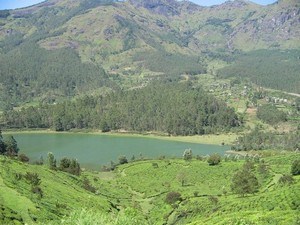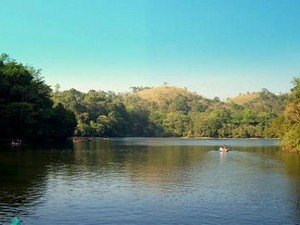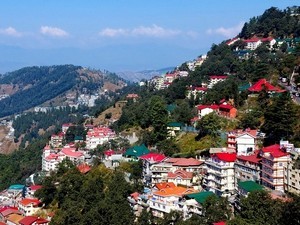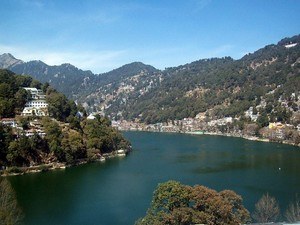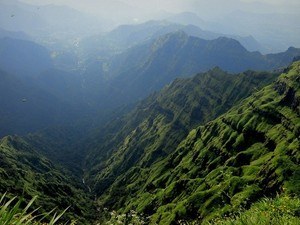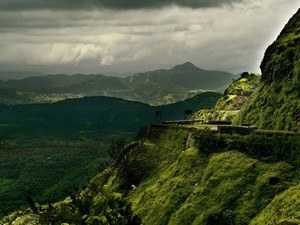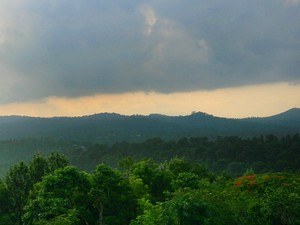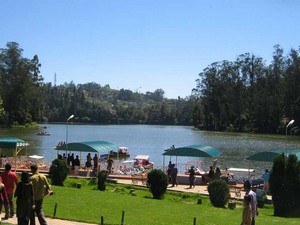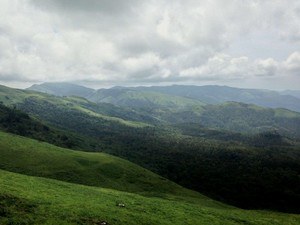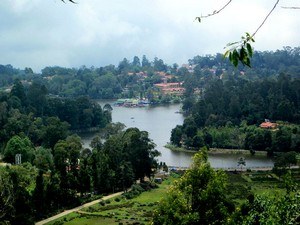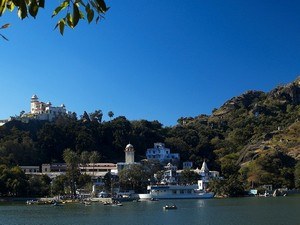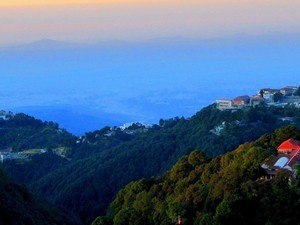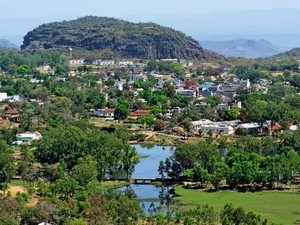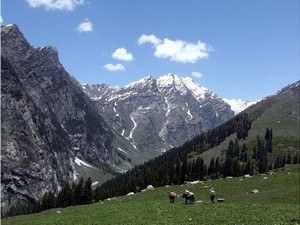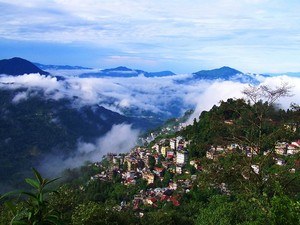1
DAY 1 : TRAVEL TO DARJEELING
DAY 1 : TRAVEL TO DARJEELING
 Sightseeing
Sightseeing
Leisure / No Sightseeing
2
DAY 2 : DARJEELING SIGHTSEEING
%%Itinerary_Title_Day2%%
At a distance of 11 km from Darjeeling Himalayan Railway Station, Tiger Hill is a sunrise viewpoint in Darjeeling. It is the highest point in Darjeeling and among the most picturesque places to visit in Darjeeling.
Tiger Hill stands at an altitude of 2,590 m overlooking the spur of the snow-capped mountain ranges of the Eastern Himalayas. It is one of the two points in India from where you can capture the entire panorama between Mount Everest and Kanchenjunga on a sunny morning. The first rays of the sun shoot ahead and shed light upon the twin peaks of Kanchenjunga painting it pink, and then bathing it in a beautiful orange colour, which is an amazing thing to experience.
An observation deck is built on top of the Tiger Hill to cater to hundreds of tourists who visit every day. On a clear day the summit of Tiger Hill commands the view of Kurseong Town to its south-west along with plains of North Bengal and number of major rivers like Teesta, Mahanadi, Balasun and Mechi meanders .....
 Duration of visit: 30 Mins - 1 Hr
Duration of visit: 30 Mins - 1 Hr
 Timings: 4 AM to 6 PM
Timings: 4 AM to 6 PM
At a distance of 1 km from Ghoom Railway Station and 6 km from Darjeeling, Old Ghoom Monastery, also known as Yiga Choeling Monastery, is a Buddhist monastery situated at Ghoom near the beautiful hill town of Darjeeling. It is one of the oldest and most popular Tibetan Buddhist monasteries in the region of Darjeeling and also one of the must visit places in Darjeeling.
Yiga Choeling Monastery was established in 1850 CE by the Mongolian astrologer and monk Sokpo Sherab Gyatso, who was the head of the monastery until 1905 CE. The Monastery belongs to Gelugpa or the Yellow Hat sect. This is the first ever Tibetan Buddhist monastery to be built in the Darjeeling region. During the Chinese occupation of 1959 in Tibet many high ranking monks fled to India and took refuge in this monastery.
The monastery is known for its 15 feet high statue of Maitreya Buddha or Gyalwa Shampa, which means the Buddha of the future or the Coming Buddha. This statue was created during the tenure of .....
 Duration of visit: 30 Mins
Duration of visit: 30 Mins
 Timings: 6 AM to 6 PM
Timings: 6 AM to 6 PM
At a distance of 4 km from Darjeeling Himalayan Railway, Batasia Loop is a railway loop in Darjeeling of West Bengal. Situated below the Ghoom station, it is one of the mesmerizing places to visit in Darjeeling.
Batasia Loop was built in 1919 as an engineering requirement to lower the gradient of ascent of the Darjeeling Himalayan Railway. At this point, the track spirals around over itself through a tunnel and over a hilltop. After Ghoom (the highest railway station), there is a sharp fall as the toy train moves towards Darjeeling. There was no way a narrow gauge toy train could navigate the drastic fall of about 100 feet to the gradient of the slope. So, a large circular area was built for the loop to make the slope gentle.
Batasia means airy space. The Loop serves a vital purpose for the toy train but is also an attraction in itself. The loop goes around a garden. The mountain garden is beautified with fresh green grass, seasonal and perennial flowers and shrubs. There .....
 Duration of visit: 30 Mins - 1 Hr
Duration of visit: 30 Mins - 1 Hr
 Timings: 5 AM to 8 PM
Timings: 5 AM to 8 PM
At a distance of 3 km from Darjeeling Railway Station, Padmaja Naidu Himalayan Zoological Park is a zoo situated in the beautiful hill town of Darjeeling, West Bengal. Popularly called as Darjeeling Zoo, it is one of the best zoo parks in India and among the must visit Darjeeling Tourist Places.
The zoo was formerly known as Himalayan Zoological Park and was established in 1958 as a joint venture of Government of India and Government of West Bengal. The park was renamed in 1975 when Indira Gandhi, the Prime Minister of India, visited the park and dedicated it to the memory of Padmaja Naidu, who was also a poet and daughter of the famous freedom fighter Sarojini Naidu. Situated at an altitude of 7,000 feet, this is the largest high altitude zoo in India.
Spread over an area of 67.56 acre, Padmaja Naidu Himalayan Zoological Park is the only specialized Zoo in the country and is the first recipient of the International award of 'The Earth Heroes 2014'. This zoo park is internationally .....
 Duration of visit: 1-2 Hours
Duration of visit: 1-2 Hours
 Timings: 8.30 AM to 4 PM, Closed on Thursday, Mountaineering Institute: 9 AM - 1 PM & 2 PM - 5 PM
Timings: 8.30 AM to 4 PM, Closed on Thursday, Mountaineering Institute: 9 AM - 1 PM & 2 PM - 5 PM
At a distance of 3 km from Darjeeling Himalayan Railway, Bengal Natural History Museum is a museum situated in Darjeeling town of West Bengal. Located inside Padmaja Naidu Himalayan Zoological Park complex, it is one of the best places to visit in Darjeeling.
The Bengal Natural History Museum was established in 1903 at the behest of the then Governor General of India Mr. George Nathaniel Curzon. Established as a small museum within the premises of the Lloyd Botanical Garden, it provides visitors with a wonderful view of rich flora and fauna of Darjeeling and its surrounding areas. However, due to the growing visitors and increasing collection, the museum was shifted to its current location in the year 1915, and the Bengal Natural History Museum was officially formed in the year 1923. Initially the museum was run by Bengal Natural Museum Society from 1923 to 1976 and later it was handed over to the Forest Department of West Bengal.
The Bengal Natural History Museum is a visual .....
 Duration of visit: 1 Hour
Duration of visit: 1 Hour
 Timings: 9 AM to 5 PM, closed on Thursdays and on National Holidays
Timings: 9 AM to 5 PM, closed on Thursdays and on National Holidays
At a distance of 2 km from Darjeeling Himalayan Railway Station, Observatory Hill is a hill top located near Chowrasta Square in the dreamy hill town of Darjeeling. It is one of the great places to visit in Darjeeling and among the popular viewpoints in Darjeeling. The hill is encircled at the bottom of the Mall Road.
The Observatory Hill is one of the oldest sites of attraction in Darjeeling and also has historical and religious significance. Built in 1765 CE by Lama Dorje-Rinzing, the Bhutia Busty Monastery, the oldest monastery in Darjeeling, was first located on Observatory Hill. The monastery was sacked by a Gorkha invasion in 1815 and it was rebuilt and shifted to its present location at Bhutia Busty in 1879.
The hill is famous for its magnificent views of Kanchendzonga and the ancient temple dedicated to Mahakal or Lord Shiva. There is a white chorten or a Tibetan memorial shrine next to the Mahakal Temple, which has the relics of Dorje Lama who was the caretaker of .....
 Duration of visit: 1 Hour
Duration of visit: 1 Hour
 Timings: 6 AM to 6 PM
Timings: 6 AM to 6 PM
At a distance of 1 km from Darjeeling Himalayan Railway Station, Darjeeling Mall or Chowrasta is located at the heart of Darjeeling town. It is considered as the hub for all type of activities in Darjeeling and also among the best places to visit in Darjeeling.
The word 'Chow' means four and 'Rasta' stands for roads, essentially means that the Mall is where four roads meet. Located on top of Nehru Road, This flat piece of circular land is the major shopping area and center for commercial activities. In olden days, this was the place where the Europeans came for their evening walks. Today, the locals as well as the tourists come here to lounge and relax. In a clear day, one can also have a magnificent view of the Kanchenjunga from here.
There are benches all along the Mall Road for people to sit and enjoy the views over a cup of Darjeeling tea. Also, there are some of the old and heritage stores lined up and countless vendors selling artifacts, woollens and various figurines .....
 Duration of visit: 1 Hour
Duration of visit: 1 Hour
 Timings: 8 AM - 8 PM
Timings: 8 AM - 8 PM
3
DAY 3 : DARJEELING SIGHTSEEING
%%Itinerary_Title_Day2%%
The Darjeeling Himalayan Railway, also known as the Toy Train, is a 2 feet narrow-gauge railway based on zig zag and loop line technology that runs between Siliguri and Darjeeling in the Indian state of West Bengal. The Darjeeling Himalayan Railway is the first and still the most outstanding example of a hill passenger railway and among the top Darjeeling Tourist Places.
Built between 1879 & 1881, the narrow gauge Darjeeling Himalayan Railway was designed as an extension of the North Bengal State Railway. Running up to a height of over 7,000 feet, the Darjeeling Himalayan Railway is one of the oldest and highest railway lines in the world. The Toy Train begins its journey from Siliguri and reaches Darjeeling after covering a distance of 78 km and crossing 13 stations on its way, including Ghoom, the highest station in India.
The Darjeeling Himalayan Railway, a UNESCO World Heritage, still operates with the original steam engines and it attracts tourists not only from India .....
 Duration of visit: 1-2 Hours
Duration of visit: 1-2 Hours
 Timings: Joy Ride (Darjeeling to Ghoom): 8 AM, 10. 40 AM, 1.20 PM & 4 PM
Timings: Joy Ride (Darjeeling to Ghoom): 8 AM, 10. 40 AM, 1.20 PM & 4 PM
At a distance of 2.5 km from Darjeeling Railway Station, Happy Valley Tea Estate is a vast tea garden located in Darjeeling town of West Bengal. This is the second oldest tea estate in Darjeeling after Steinthal Tea Estate and also one of the popular places to experience Darjeeling Tourism.
Spread over an area of 177 hectares, Happy Valley Tea Garden was established by Mr. David Wilson in the year 1854, which was then known as Wilson Tea Estate. In 1903, the estate was taken over by an Indian, Tarapada Banerjee, an aristocrat from Hooghly. Later Banerjee bought the Windsor Tea Estate nearby in 1929 and merged the two estates under the name of Happy Valley Tea Estate. Since 2008, the tea estate has been under the ownership of Sanjay Bansal. Today, over 1500 people worked in the tea estate.
Located in the vicinity of Darjeeling town, it is one of the major tourist attractions in Darjeeling. It also has a museum and has a factory. Situated at an altitude of 2,100 m, Happy Valley .....
 Duration of visit: 1-2 Hours
Duration of visit: 1-2 Hours
 Timings: 8 AM to 4 PM, closed on Sunday & Monday
Timings: 8 AM to 4 PM, closed on Sunday & Monday
At a distance of 4 km from Darjeeling Himalayan Railway, Darjeeling Rangeet Valley Passenger Ropeway is a passenger ropeway located in Darjeeling town of West Bengal. Also known as Darjeeling Ropeway, it is one of Asia's longest Passenger Ropeways and also the first Passenger Ropeway in India.
Darjeeling Ropeway was started in 1968 by the Forest Development Corporation of West Bengal. It was initially set up to cater to the tea gardens at the valleys below which did not otherwise have an easy access. Starting with just one cable car, now it was upgraded to 16 cable cars each having a capacity of six persons. It was closed in 2003 after four tourists died when the cable broken causing two cars to fell down the hill. Later it was re-opened with many safety measures in 2012.
Darjeeling Ropeway operates between the North Point in the town of Darjeeling and Singla on the banks of the Ramman River. From an elevation of 7000 feet in Darjeeling's North Point, this ropeway descends .....
 Duration of visit: 2 Hours
Duration of visit: 2 Hours
 Timings: 10 AM to 4 PM (Winter & Monsoon) & 10 AM to 2 PM (Summer & Autumn), closed on 15th of every month
Timings: 10 AM to 4 PM (Winter & Monsoon) & 10 AM to 2 PM (Summer & Autumn), closed on 15th of every month
At a distance of 5 km from Darjeeling Himalayan Railway Station, Tibetan Refugee Self Help Centre is a rehabilitation center for the Tibetan refugees in the beautiful hill town of Darjeeling, West Bengal. It is one of the prominent landmarks of Darjeeling and also one of the best places to visit in Darjeeling.
The center was setup by Tibetan refugees on 2nd October 1959 AD. It serves as a residence of several Tibetan refugees who fled from their homeland following the footsteps of their spiritual leader, the Dalai Lama. Located on the picturesque hilltop, it is spread over an area of 4 acres of land. A committee was formed with 10 members that were responsible for the development and management of the center. Ms Gaylo Thondup was the first President of the center. Initially, they started raising funds through donations, subscriptions, charity shows and even through exhibition soccer match. Later, they received funds from domestic and international voluntary organizations as well. .....
 Duration of visit: 1 Hour
Duration of visit: 1 Hour
 Timings: 9 AM to 4.30 PM, Closed on Sundays
Timings: 9 AM to 4.30 PM, Closed on Sundays
At a distance of 1 km from Darjeeling Himalayan Railway Station, Lloyd's Botanical Garden or Darjeeling Botanical Garden is a beautiful garden located in the beautiful hill town of Darjeeling. The garden is among the oldest botanical gardens in Darjeeling and also one of the popular tourist places in Darjeeling.
Established in 1878 CE, the garden was named after William Lloyd, who provided the required land for it. The garden was built in reference to the Calcutta Botanical Garden. The basic motive of Lloyd's Botanical Garden is to preserve the native floral species of Darjeeling Himalayan hill region, Sikkim and its neighboring regions. Located at an altitude of almost 1800 meters, the garden has terraced lands, rolling slopes, tall trees and lush green bushes mixed with grass.
Sprawling over an area of 40 acres, the Lloyd Botanical Garden preserves some of the most exotic and endangered species of plants. It has several species of bamboo, oak, magnolia, arisaema, cotoneaster, .....
 Duration of visit: 1 Hour
Duration of visit: 1 Hour
 Timings: 6 AM to 5 PM
Timings: 6 AM to 5 PM
4
DAY 4 : DARJEELING SIGHTSEEING & TRAVEL TO SILIGURI
%%Itinerary_Title_Day2%%
At a distance of 2.5 km from Darjeeling Himalayan Railway, Darjeeling Peace Pagoda is a Buddhist stupa situated on the slopes of the Jalapahar hill in Darjeeling. It is one of more than 70 pagodas built around the world by the Japanese Buddhist Nipponzan Myohoji organization and among the most popular attractions in Darjeeling.
The foundation stone of the pagoda was laid in 1972 by Nichidatsu Fuji, a Buddhist monk from Japan and founder of the Nipponzan-Myohoji Buddhist Order. Inaugurated in 1992, the pagoda was designed by M. Ohka. Being the tallest structure in Darjeeling with a height of 28.5 meters, it is open to people of all faith and is purposely made to propagate peace and prosperity in the world.
Peace Pagoda houses four shining and gold-polished statues of Buddha. Also, the walls of the temple have eight sandstone carvings which depict different stories from the different stages of Gautama Buddha's life. Known for its tranquility, Peace Pagoda offers breathtaking .....
 Duration of visit: 1 Hour
Duration of visit: 1 Hour
 Timings: 4 AM to 7 PM
Timings: 4 AM to 7 PM
At a distance of 2.5 km from Darjeeling Railway Station, Dali Monastery is a Buddhist monastery located in Dali area of Darjeeling. Also known as Druk Sangag Choling Monastery, it is one of the biggest monasteries in West Bengal and also among the famous places to visit in Darjeeling.
Dali Monastery is one of the most prominent monasteries of the Kargyupa sect, built by Kyabje Thuksey Rinpoche in 1971. The gompa was inaugurated by His Holiness Dalai Lama in 1993, where he gave 3 days of religious teachings. The monastery is known for preserving the age old culture and tradition of the Tibetan monks. It serves as the headquarters and the residence for Drukchen Rinpoche the XII, who is the supreme leader of the Kargyupa sect.
Perched on a steep hill, the monastery was built in the traditional Tibetan style. The colors used in the walls are bright and bold which depicts the life and teachings of Lord Buddha. It is home to around 210 monks who came to live here from the Himalayan .....
 Duration of visit: 30 Mins
Duration of visit: 30 Mins
 Timings: 7 AM to 7 PM
Timings: 7 AM to 7 PM

